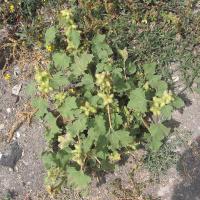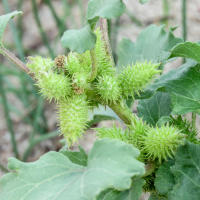Cocklebur
Xanthium strumarium
Appearance:
- Cocklebur typically grows as a robust annual plant with erect or branching stems that can reach heights of up to 3 to 5 feet (approximately 1 to 1.5 meters).
- The leaves of cocklebur are alternate, large, and deeply lobed, resembling the shape of a maple leaf. They are often covered with fine hairs.
- The plant produces inconspicuous greenish-yellow flowers that are borne in clusters at the leaf axils.
- One of the most distinctive features of cocklebur is its spiny fruit, which consists of two seeds enclosed in a hard, burr-like structure covered in hooked spines. These burrs are easily attached to clothing, fur, or feathers, aiding in seed dispersal.
Habitat:
- Cocklebur is a highly adaptable plant and can be found in a variety of habitats, including disturbed areas, roadsides, fields, riverbanks, and wetlands.
- It is known to thrive in both dry and wet conditions and can tolerate periods of flooding.
Lifecycle:
- Cocklebur is an annual plant, completing its life cycle within a single growing season.
- It reproduces primarily by seeds, which are contained within the spiny burrs.
- The seeds are dispersed by attaching to animals, machinery, or other objects, allowing the plant to spread to new locations.
Impact:
- Cocklebur is considered a weed in agriculture because it competes with cultivated crops for resources such as water, nutrients, and sunlight.
- The spiny burrs can be problematic for livestock and wildlife, as they can attach to fur or feathers, causing irritation and potentially affecting animal health.
- It is also considered a noxious weed in some regions, leading to efforts to control its spread.
Control:
- Control measures for cocklebur may include manual removal of plants before they produce seeds, mowing or cutting before flowering and seed formation, and the use of herbicides in agricultural settings.
- Preventing seed production and seed dispersal is crucial in managing cocklebur populations.











Prodotti fitosanitari
- N/A
- N/A
- N/A
- N/A
- N/A
- N/A
- N/A
- N/A
- N/A
- N/A
- N/A
- N/A
- N/A
- N/A
- N/A
- N/A
- N/A
- N/A
- N/A
- N/A
- N/A
- N/A
- N/A
- N/A
- N/A
- N/A
- N/A
- N/A
- N/A
- N/A
- N/A
- N/A
- N/A
- N/A
- N/A
- N/A
- N/A
- N/A
- N/A
- N/A
- N/A
- N/A
- N/A
- N/A
- N/A
- N/A
- N/A
- N/A
- N/A
- N/A
- N/A
- N/A
- N/A
- N/A
- N/A
- N/A
- N/A
- N/A
- N/A
- N/A
- N/A
- N/A
- N/A
- N/A
- N/A
- N/A
- N/A
- N/A